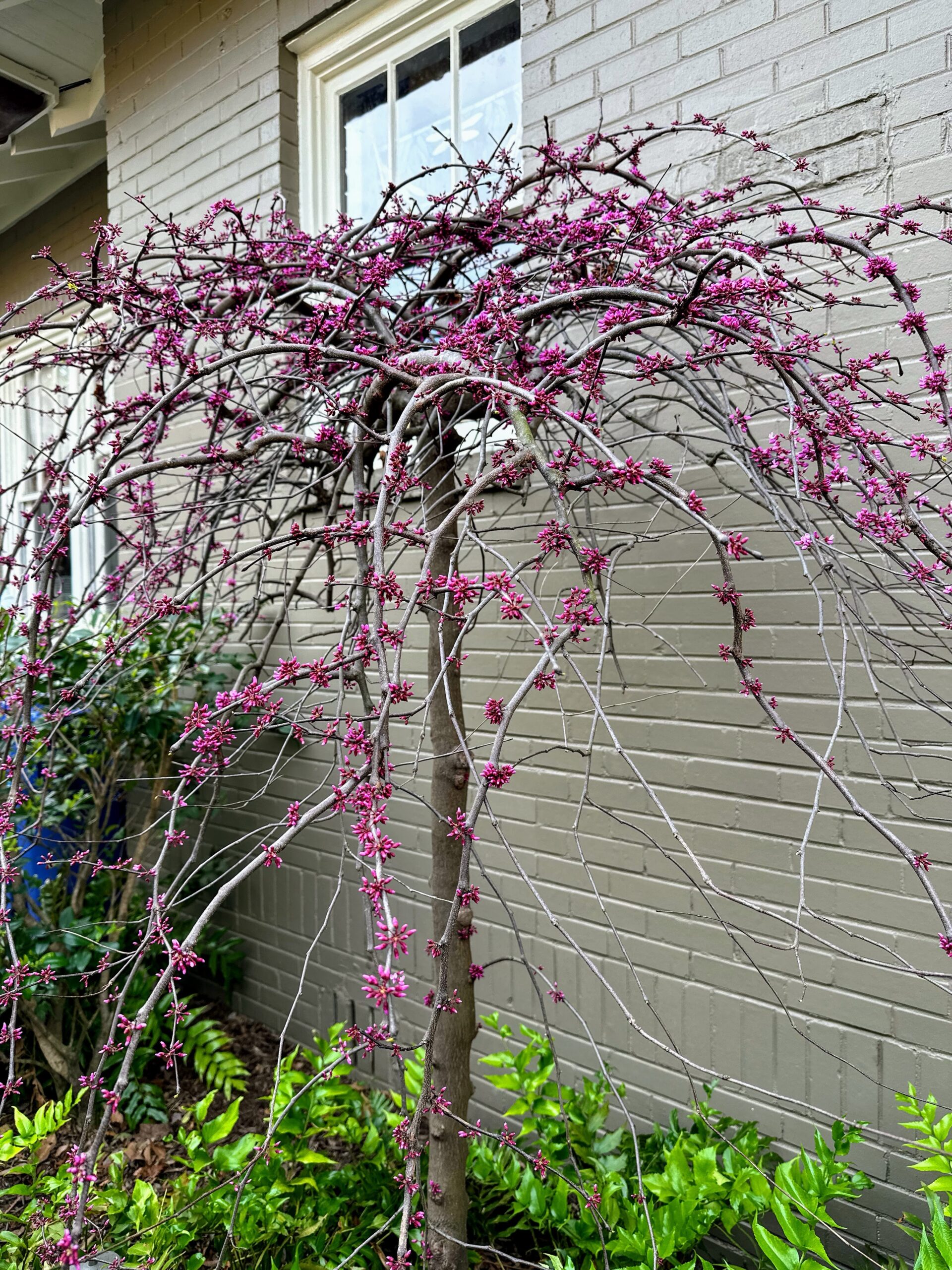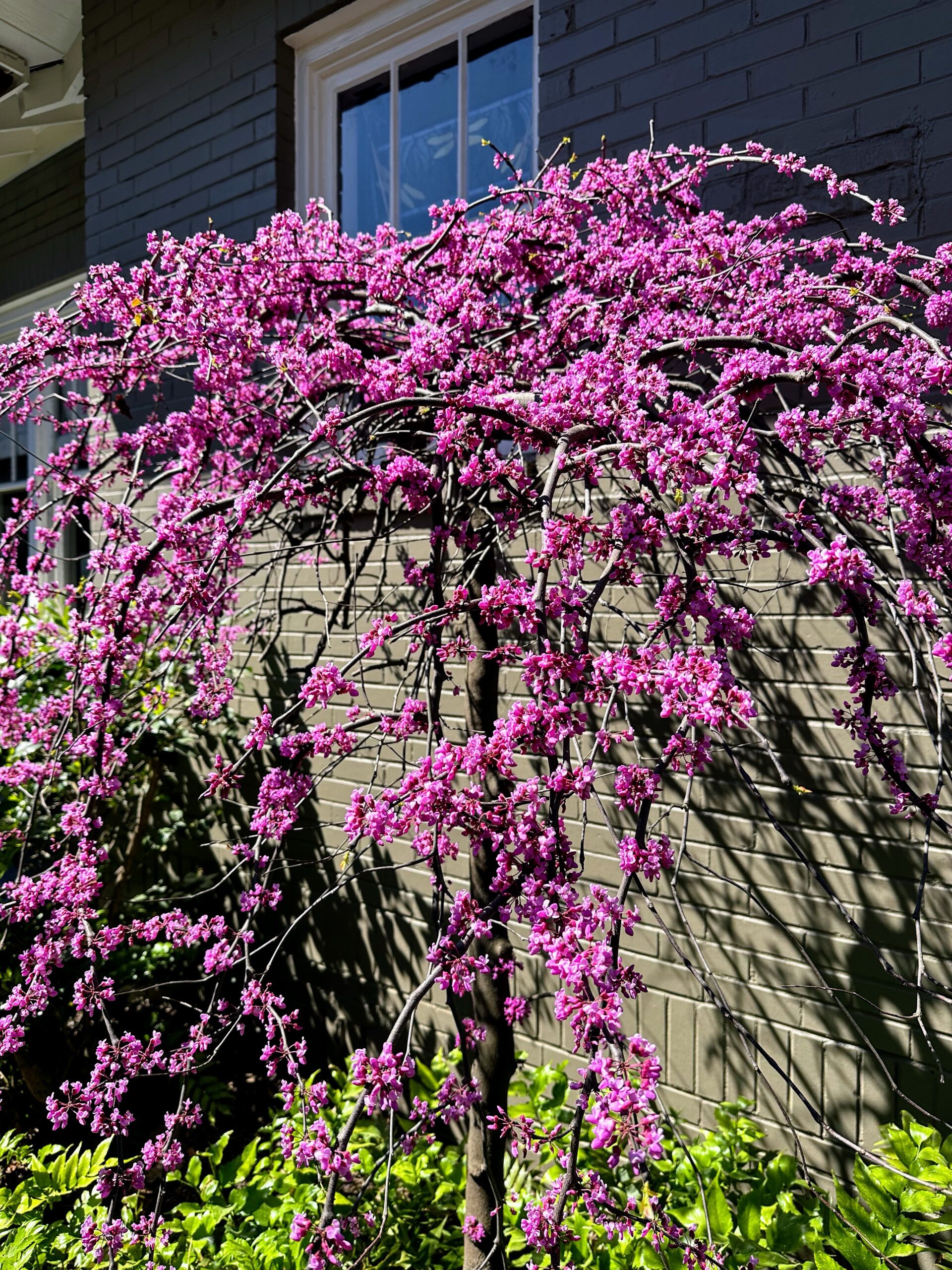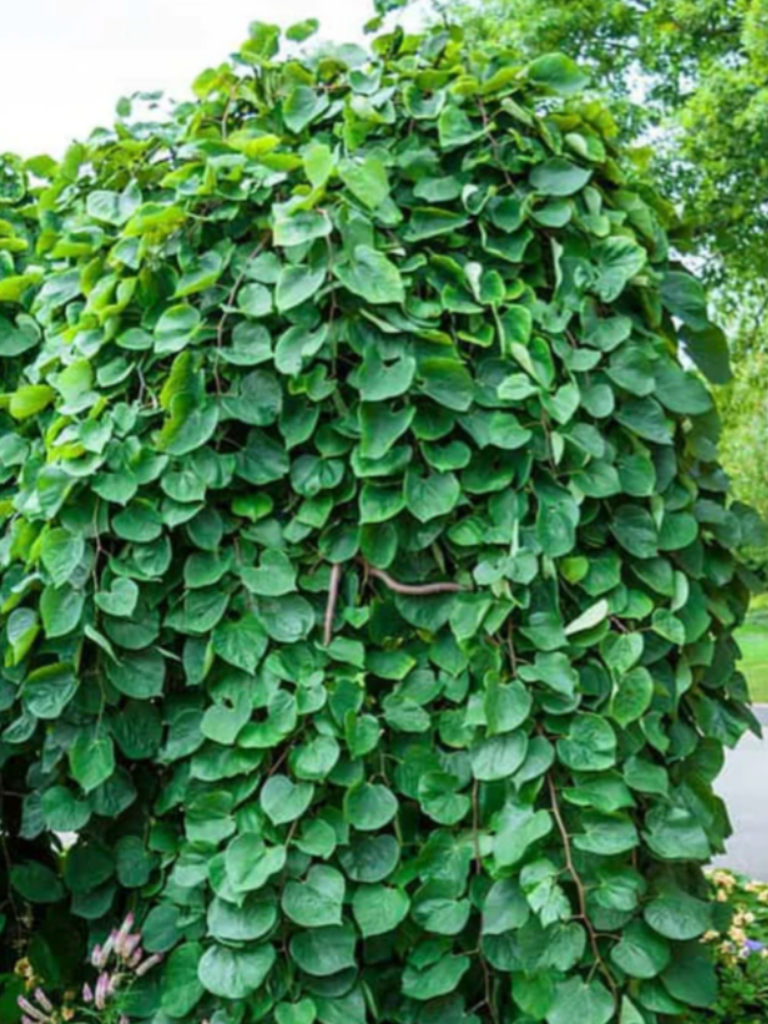Visit my spring garden and discover the secret life of a Weeping Redbud tree in full bloom as it attracts pollinators and even a green anole.

Weeping Redbud starting to bloom

Weeping Redbud in full bloom

Weeping Redbud in summer
About Eastern Weeping Redbuds
Probably one of the most-asked questions when people visit my garden, is about my Weeping Redbud tree (Cercis canadensis ‘Covey’). This gorgeous tree has a beautiful form year round, but in the spring, for just a few glorious weeks, it blooms bright pink and buzzes with the sound of bees.
I have to thank my landscape architect, John B. Carran, for introducing me to this tree. When he presented me with a plan for my garden, he included a Weeping Redbud to be planted right outside my kitchen window. Until then, I had no idea that Redbuds wept.
I have always loved the early bloom of Redbuds in the wild as well as here and there in yards throughout our neighborhood. For the past seven years, I have enjoyed watching this tree in my garden mature into a favorite spot for bees and birds to visit year round.
Weeping Redbud History
The weeping redbud was “discovered” in 1991 in the garden of Cornelia (Connie) Covey in western New York state. The plant had been given to her by her mother and brother upon their return from a trip to Florida. Connie’s mother told her to plant it in the yard, which she did.
Connie’s little tree grew in her garden for 30 years when the former owners of Westfield Nursery, Charlie and Nancy Hanks of Westfield, New York, heard about it. Interested in possibly giving a small tree as a gift, they asked Tim Brotzman, owner of Brotzman Nursery in Madison Ohio, for help to propagate a tree from Connie’s plant.
Nancy sent Tim scions from Connie’s plant along with photographs, and Tim was eventually successful in propagating a new plant from one of 50 cuttings.
When Brotzman saw Connie’s tree in bloom, he commented to her that it was full of “lavender twists.” The name stuck. When he patented the plant in 1998, he called it Lavender Twist Cercis canadensis ‘Covey’.
Connie not only agreed to sell Brotzman the rights to propagate her tree, but she eventually allowed him to transplant it to his nursery in Ohio when she decided to move to a home with less property. Brotzman successfully transplanted the tree with the help of Charlie Hanks to Brotzman Nursery in Ohio. Thirty years later, the Brotzman Nursery website features images of this plant on their landing page.
And now you know who we must thank for this gorgeous tree that so many of us enjoy in our gardens!

Connie Covey and her dog, Luke posing with her weeping redbud at her home in western New York prior to 1998. Photo was copied from the Brotzman Nursery website.
Video. Birds, Bees, and a Green Anole:
The Secret Life of my Weeping Redbud
To see additional videos of my garden, visit my In the Garden page on this website.
Growing Weeping Redbuds
About
Redbuds are the earliest bloomers in my yard along with loropetalum, cherry, daffodils, and hyacinth. Plant redbuds where they will receive sun for 6-8 hours a day. Especially in the south where summers can be brutal, position them where they will get a bit of shade during the hot months. Mine is planted on the east side of my house against the house. It gets full sun in the morning and is shaded by the house in the afternoon.
While the growing zones for eastern redbuds range from zones 4-9, weeping redbuds are a bit less cold-tolerant and grow best in zones 5-9. Check your growing zone and the variety you are planting for cold- and heat-tolerance. Popular varieties are Ruby Falls and Twisted Lavender, but there are many others. Read the descriptions carefully before deciding what to plant.
Planting
Plant redbuds in well-drained soil. Dig the hole twice as wide and a good bit deeper than the root ball. Mix peat moss and compost into the soil and plant the tree only as deep as it was in the pot, firmly packing the soil in around the root ball. Water thoroughly. Water deeply once a week during the first year.
Mulch
Apply mulch to within 2-3” of the stem. Be careful NOT to pile mulch up against the trunk of the tree or for that matter, any other tree in your garden. Mulch is used to smother weeds, conserve water by slowing down evaporation, and protect the roots or trees, shrubs, and other plantings. If piled against the trunk of a tree, however, it can damage the cambium layer and severely impair the plant’s ability to transport water and nutrients from the roots to the upper parts of the plant.
Staking and Training
Plant your tree alongside a sturdy stake and tie the trunk it to the stake. Then select a branch that is growing as close to upright from the trunk as you can find and attach it to the stake. As the tree grows, keep encouraging the top branch up by tying it to the stake. Be sure to check the ties every few months because as your tree grows, it will outgrow the ties which will need to be removed and replaced with bigger ones.
I mention this because I once planted a Japanese maple that had a protective plastic coil wound around its base to protect it from sunscald and rodents. I left it there for about 18 months thinking it would protect the tree. Two years later, my daughter pointed out that the plastic had girdled the tree, and the bark was beginning to grow around it! So, be careful with anything you place around a tree. Trees grow. Ties (and Christmas lights) don’t.
Pruning
It used to scare the crap out of me to prune trees and bushes. I have gained confidence through experience, and so will you. Most trees do need a bit of pruninig when they are young to shape them and encourage them to the form you want. Prune judiciously, as you can always take off a branch later that you weren’t sure about, but you can’t put branches back on a tree.
This article on trimming weeping trees and shrubs is a good one for understanding pruning basics for weeping forms. Take off any diseased or damaged branches first. Next, trim out branches that are crossed or crowded. Prune bottom branches to encourage upward growth to the height you want.
Most weeping redbuds reach a height of about 6’ – 8’. For my plant, which is underplanted with holly ferns, I also prune a bit up from the bottom, so my tree doesn’t weep all the way to the ground where it would compete with the ferns.